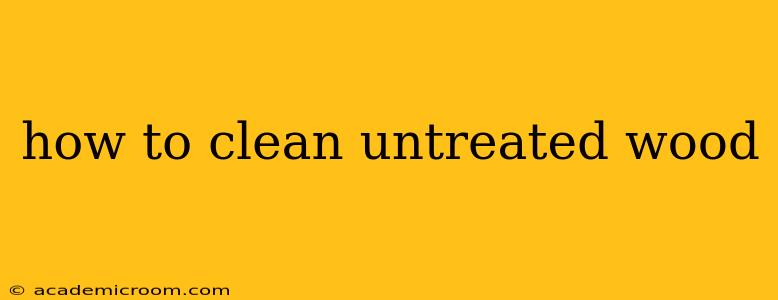Untreated wood, with its natural beauty and rustic charm, adds a unique touch to any space. However, its porous nature makes it susceptible to dirt, grime, and the elements. Knowing how to properly clean untreated wood is crucial for preserving its longevity and aesthetic appeal. This guide will provide you with everything you need to know, covering various cleaning methods and addressing common concerns.
What are the Different Types of Untreated Wood?
Before diving into cleaning methods, it's important to understand the different types of untreated wood you might encounter. This will influence the cleaning approach. Some common examples include:
- Pine: A softwood known for its affordability and light color.
- Oak: A hardwood prized for its durability and rich grain.
- Cedar: A fragrant and naturally resistant wood often used outdoors.
- Reclaimed wood: Wood salvaged from older structures, often containing unique markings and imperfections.
The cleaning method you choose will depend on the type of wood, its finish (if any), and its location (indoor or outdoor).
How to Clean Untreated Wood Indoors
Cleaning indoor untreated wood requires a gentle approach to avoid damage. Here's a step-by-step guide:
-
Dust: Begin by removing loose dust and debris using a soft-bristled brush, a vacuum cleaner with a brush attachment, or a microfiber cloth. Always dust with the grain of the wood to avoid scratching.
-
Mild Soap Solution: For light cleaning, mix a small amount of mild dish soap (like Dawn) with warm water. Dip a soft cloth into the solution, wring it out thoroughly to avoid excessive moisture, and gently wipe the surface, again following the wood grain.
-
Rinse and Dry: Rinse the surface with a clean, damp cloth and immediately dry it thoroughly with a clean, dry cloth. Leaving any moisture behind can lead to water damage or mold growth.
-
Conditioning (Optional): For particularly dry wood, consider applying a wood conditioner after cleaning. This will help replenish lost moisture and prevent cracking.
How to Clean Untreated Wood Outdoors
Outdoor untreated wood faces harsher conditions, requiring more robust cleaning methods:
-
Pre-Cleaning: Remove loose dirt, leaves, and debris with a broom or garden hose. A pressure washer can be used, but be cautious; excessive pressure can damage the wood. Maintain a safe distance and use a low-pressure setting.
-
Cleaning Solution: For outdoor wood, you might need a stronger cleaning solution. A mixture of water and oxygen bleach is a safe and effective option for removing mildew and stains. Always test the solution on an inconspicuous area first to check for any adverse reactions.
-
Scrubbing: Use a stiff-bristled brush to scrub the wood gently, following the grain. For stubborn stains, allow the cleaning solution to sit for a few minutes before scrubbing.
-
Rinsing and Drying: Thoroughly rinse the wood with clean water and allow it to air dry completely.
What's the Best Way to Clean Mildew Off Untreated Wood?
Mildew is a common problem for untreated wood, especially in damp environments. A solution of oxygen bleach and water (following the product's instructions) is effective at removing mildew. Always test it on a hidden area first. Scrub gently with a brush and rinse thoroughly. For persistent mildew, consider using a commercial mildew remover designed for wood.
How Do You Clean Greasy or Oily Untreated Wood?
Grease and oil can be stubborn stains on untreated wood. Start by absorbing excess oil with paper towels. Then, mix a small amount of dish soap with warm water and gently scrub the affected area with a soft cloth or brush. Rinse thoroughly and dry completely. For persistent greasy stains, a degreasing cleaner might be necessary, but always test it in an inconspicuous area first.
Can I Use Bleach to Clean Untreated Wood?
While bleach can effectively kill mold and mildew, it's generally not recommended for untreated wood. Bleach can discolor the wood, making it look dull or uneven. Oxygen bleach is a safer alternative as it's less harsh and less likely to cause discoloration. Always test any cleaning solution on a hidden area before applying it to the entire surface.
How Often Should I Clean Untreated Wood?
The frequency of cleaning depends on the location and the level of exposure to dirt and grime. Indoor wood might only need dusting weekly, with occasional cleaning with soap and water. Outdoor wood may require more frequent cleaning, potentially every few months or as needed, depending on weather conditions and environmental factors.
By following these guidelines and choosing the appropriate cleaning method for your specific type of untreated wood, you can maintain its natural beauty and ensure its longevity for years to come. Remember, prevention is key – regular dusting and prompt attention to spills will minimize the need for deep cleaning.
